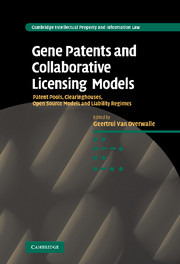 Gene Patents and Collaborative Licensing Models
Gene Patents and Collaborative Licensing Models Book contents
- Frontmatter
- Contents
- List of contributors
- Preface
- Foreword: Jean-Jacques Cassiman
- List of abbreviations
- Part I Patent pools
- Part II Clearinghouses
- Part III Open source models
- Part IV Liability regimes
- 17 Pathways across the valley of death. Novel intellectual property strategies for accelerated drug discovery
- 18 Case 10. The International Treaty on Plant Genetic Resources for Food and Agriculture (ITPGRFA). The Standard Material Transfer Agreement as implementation of a limited compensatory liability regime
- 19 Critical analysis: property rules, liability rules and molecular futures. Bargaining in the shadow of the cathedral
- Part V Different perspectives
- Part VI Summary and concluding analysis
- Index
- Titles in the series
19 - Critical analysis: property rules, liability rules and molecular futures. Bargaining in the shadow of the cathedral
from Part IV - Liability regimes
Published online by Cambridge University Press: 14 January 2010
- Frontmatter
- Contents
- List of contributors
- Preface
- Foreword: Jean-Jacques Cassiman
- List of abbreviations
- Part I Patent pools
- Part II Clearinghouses
- Part III Open source models
- Part IV Liability regimes
- 17 Pathways across the valley of death. Novel intellectual property strategies for accelerated drug discovery
- 18 Case 10. The International Treaty on Plant Genetic Resources for Food and Agriculture (ITPGRFA). The Standard Material Transfer Agreement as implementation of a limited compensatory liability regime
- 19 Critical analysis: property rules, liability rules and molecular futures. Bargaining in the shadow of the cathedral
- Part V Different perspectives
- Part VI Summary and concluding analysis
- Index
- Titles in the series
Summary
Introduction
The chapters in this volume on pharmaceutical development and on the International Treaty on Plant Genetic Resources for Food and Agriculture (ITPRGFA) are oriented toward the use of liability rules to promote innovation. Each describes an attempt to re-align the incentives of innovators by structuring a set of contractual options that will overcome the barriers to investment. In response to the formidable barriers to development of viable pharmaceuticals from private libraries of receptors and ligands, Rai et al. propose the creation of a private molecular “semi-commons” of pooled molecules from which promising drug targets could be tested, and for which a contributor would be paid if a viable product resulted. In a similar vein, Henson-Apollonio reports on the structure of the ITPRGFA, which allows use of genetic resources with the guarantee of a royalty if a contributor's variety is used.
A common feature of these systems is a type of conscription mechanism that permits a participant in the system to use intellectual property (IP) without a direct negotiation with the IP owner. Users of an asset are required to pay for their use of the asset; they cannot be refused use of that asset but they control the decision whether to take the asset or not. In other words, owners of the asset have a right to payment, but not a right to exclude.
- Type
- Chapter
- Information
- Gene Patents and Collaborative Licensing ModelsPatent Pools, Clearinghouses, Open Source Models and Liability Regimes, pp. 294 - 308Publisher: Cambridge University PressPrint publication year: 2009
- 3
- Cited by


